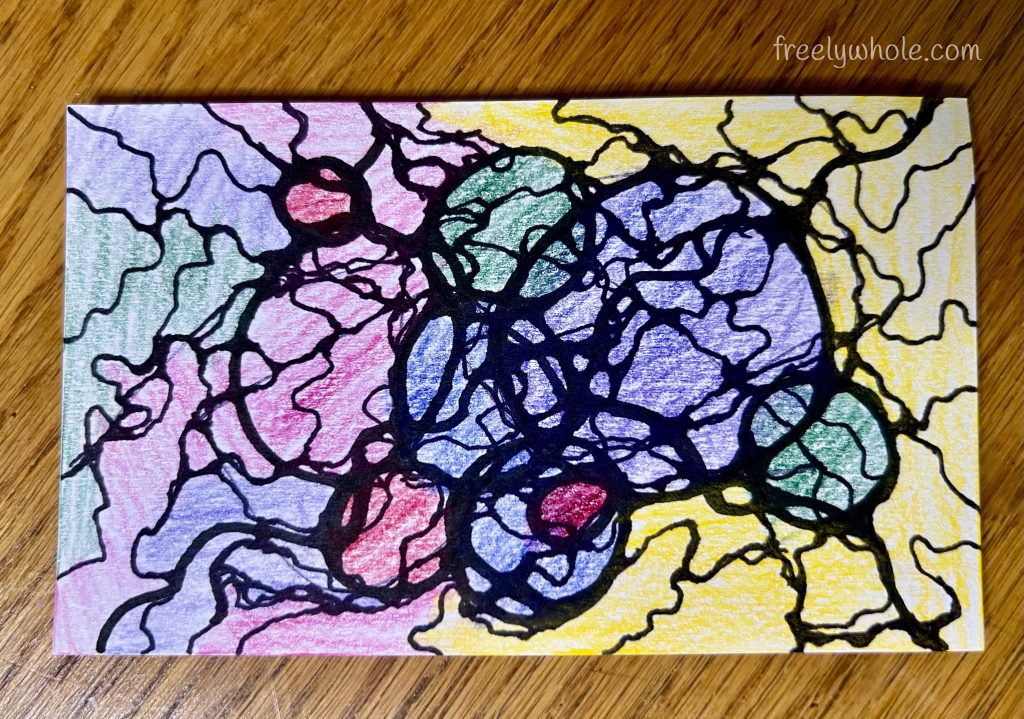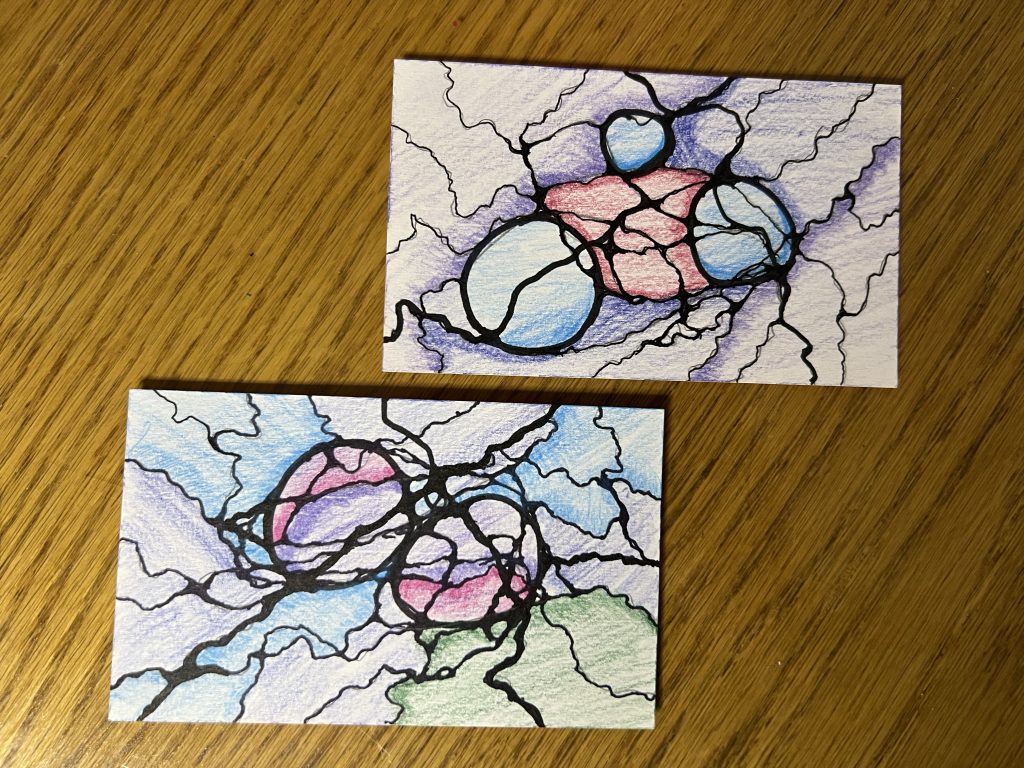Sometimes we just can’t express in words what we want to say or our feelings. But we all know a picture paints 1000 words. When emotions are bottled up, or we’re feeling stuck and aren’t seeing solutions, art provides a way to release our feelings, emotions and thoughts without words. Creative activity provides that release and relieves stress. But specific artistic techniques can go even further than that.

Although all kinds of art, crafting, and other creative expressions can have therapeutic benefits, (and I share many of those types of creative expression on this site,) the therapeutic art exercise I’m sharing today stands on principles based on neuro-science, for activating brain pathways for specific healing and growth, rewiring the brain. Whether you are wanting to rewire your brain post-trauma or abuse, or calm fears and anxieties, or expand your mindset for personal growth, or even just reduce daily stress and enjoy some calming creative time, I think you’ll enjoy and benefit from this exercise. If you are dealing with severe trauma, this does not replace counseling with your trauma-educated therapist.
I’ve written an Introductory article on my take on this technique, Neurographica, and its background. This second article is a continuation of that one, and goes along with the video below (and on my YouTube channel,) giving more details of my understanding and application of the basic principles. You’ll also find expanded tips on the supplies used in that Intro article. I am not a certified teacher of Neurographica. This is just my personal use for Soul Care and self-therapy.

In the video, I’ll be doing an Express drawing, on a blank index card, that can be completed in about 30 minutes, as an introduction to this type of soul care. This exercise is specifically to reduce stress and trauma effects. But like all “therapies”, it’s not a one-and-done activity. Repeat often, to continue growth and healing.
Also, this is not about creating a beautiful art project, this is an artistic, brain-rewiring process.
I hope you enjoy this video, and give Neurographica-inspired art a try. If you want official instruction in Neurographica, check out their website and certified courses.
Preparation: I believe in multi sensory learning, and the benefits in healing by involving as many of the senses as possible. If you have dōTerra real plant essential oils, apply and or diffuse one that works for your desired outcome, Adaptiv is great to calm anxious feelings, Peace, Cheer, Motivate, Console, Passion, or perhaps Balance just to help create homeostasis, are other possible choices. Put on your calming worship playlist, or Wholetones healing music therapy.
Watch the video to walk through applying the principles. There are a few added notes and tips below, but not the complete process. Both video and this article together will bring greater understanding.
Catharsis: Put your feet flat on the floor, hands on your paper, holding your pencil. Take a few deep breaths. Think about the issue bringing you stress, frustration, anxiety, fear, anger, grief. Rate those feelings, on a scale of 1-10. Now let all those feelings go from your brain into your hand and release them in a “scribble”. Take another deep breath.
Think about your topic as you continue doing this whole exercise, letting those thoughts go where they will. For me, it usually (at least eventually) goes to an area in God’s Word and His Truth that applies. I like to begin also with prayer, something along these lines. “God, you know the feelings I’m having surrounding this situation. I feel stuck. I don’t know how/am unable at this point to resolve this. Please bring your healing touch to my body and emotions. And please guide me through this issue to the other side, bringing resolution to this. You know how this is all going to work out, and I choose to trust you and follow you.”
Neurolines: are foundational to Neurographica. They resemble the neurons in our brains. Draw them free flowing but not mindless. Watch the tip of your pen as you draw them. A neuroline isn’t straight, it doesn’t repeat itself, has no pattern, and goes where we don’t expect. To me it is like a flowing stream, meandering. These lines represent your thoughts and processes on the topic, and also the resources you have to help you resolve it, including outside help. If you have trouble, wanting to control your line, grab a coin or button, and slowly push it around on your paper wherever it goes. Lines go to the edge of the paper.
Rounding: Sharp corners represent conflict, challenges, threats, even danger. We want to smooth them out. Turn every V formed at intersections into a U. To me these are like interstate intersections, where they’ve taken the crossroads and turned them into on and off ramps. Color in the curved area created, and smooth these “joins” into the lines. In your brain, you are smoothing over your problem, creating new perspectives and solutions. Add more neurolines any time during the rest of the process, and round them each time more are added.
Coloring: Integrates the sections together, bringing unity across the lines. Use at least 3 colors. Choose each intuitively, and color sections intuitively, whatever you want at the moment. Don’t color each segment separately, and color at least 3 segments together, crossing the lines. Repeat colors in at least a couple places, usually. Add shading if you want.
Shapes: Neurographica uses 3 geometric shapes, circles, squares, and triangles. Circles represent safety, peace and harmony, so in drawing for stress, fear, and trauma reduction, we use circles. Be sure to round any new created angles.
Field Lines: 2-3 bolder, stronger lines, coming from outside, ascending from one edge to another. They go across the design, uniting the pieces. Represent guidance and support from without. For me that speaks of God, Who is our Helper and Guide, Holder of the solution to all problems, Who is outside of and greater than all things, but permeates and upholds all. Again, round all newly created angles.
As you finish, notice your breathing. Have you kept it slow and somewhat deep? Take a couple more intentional deep breaths. Again, rate the level of the emotion. Has that number decreased? Perhaps finish with prayer. God holds not only the future, but also you, in his hands. He knows the solution. Thank Him for bringing relief and guidance to the way forward.
I’m sure I don’t have all processes covered thoroughly, or even precisely perfectly. I’m not an expert on the theory, nor on applying it. But it is helpful to me, and I believe will be to you too.
Give this therapeutic art exercise a try, and share your creations in one of our Communities. (Links below.) Like all artistic endeavors, and all therapeutic activities, you’ll get better the more you do.
Living Coram Deo & freely whole
SDG!
~ Liberty
Please consider supporting Freely Whole ministries. Your support helps me to continue to provide Soul Healing content, to empower you and others to live a life that is Freely Whole–in Jesus!
Subscribe to my email list in the sidebar and get notifications of future posts on this website.
Join me on Facebook, Like & Follow my Freely Whole public page.
To share Soul Care Creativity, join my Freely Whole Creative Community at MeWe or Facebook,
and Follow @FreelyWhole on Instagram and hashtag your creations #freelywholecreative
💝
Living Coram Deo & freely whole
SDG!
~ Liberty—Life Restoration & Soul Transforming Creativity Coach
Empowering you to live a life that is Freely Whole—spirit, soul, and body—in Jesus!
Connect with Freely Whole on Social Media
💝
Discover more from freely whole {living}
Subscribe to get the latest posts sent to your email.





